Las Barrancas de Cobre — August 16-24, 2014
|
 |
We took the local bus (one dollar fare for seniors) to the Sacramento Airport and went through the usual check-in and boarding lines with our Davis friends Pat and Jim Grieshop.
|
|
|
Our plane was late and with a tight connection in Houston, we ran for the next gate located in another terminal. Jim and Bob missed the correct passageway, doubled back, and ran even faster to board the plane moments before departure. The flight to Chihuahua (one per day) was uneventful, and happily our baggage came on the same flight.
In the airport, we met five other members of the MexMush (Mexican Mushroom) group and hired a van to take us all to our hotel in Chihuahua, Chih. Map on right shows area of travel.
|
 |
|
| The next morning and afternoon were unscheduled and after a continental breakfast, we explored the downtown, alert to sketching opportunities (mainly interesting buildings) that provided a seat and shaded vantage point (there was a very hot sun).Several churches and civic buildings met these criteria. The city of Chihuahua is the capital of the state of the same name. It features many historic buildings along with statues and murals of revolutionary figures. |
 |
|

Cathedral detail, Chihuahua
|
|
|

|

Palacio Federale, detail shown on left
|
|

Pottery exhibit from Mata Ortiz
|
In the public market, Bob found no fruit or veggies he had not previously painted, opting instead for oranges (for morning Vitamin C rather than drink the diluted “jugo” served in the various hotels).
The downtown was clean and prosperous with great street furniture. It is a good walking city with clearly indicated street names. Drivers were respectful of pedestrians and there were traffic lights at major intersections and a few streets closed to cars. A major highway was diverted underground, and there was a subterranean bus stop.
There were a zillion cowboy boot stores, and many shops displayed colorful school knapsacks. |
|
 |
We had lunch at a cowboy-themed restaurant named El Rodeo, drinking Mexican beer rather than the local water, a practice we followed throughout the trip unless assured that the water had been purified.

|
|
| That evening we joined the rest of our tour group plus the previous week’s tour group at a nearby restaurant. It was a reunion of friends; most had been on previous MexMush forays led by Erik & Gundi. Our group learned about the mushrooming situation (excellent) and the likely weather— warm with lots of rain. |
| The next day we boarded a bus for a three-hour drive through the lumber town of San Jacinto to the Noritari cabins in the canyon region. Flowers bloomed in all the meadows making it difficult to remember that we were in Mexico to study fungi. The cabins are dependent on solar electricity. Following an afternoon foray and ID session led by our expert panel (Adriana, Alejandro, and David), we had a candlelight dinner. |

Display table(1)
|
|

Labeled fungi(1)
|
The following day we took the bus to the train stop in San Juanito where we boarded the famed El Chepe (Chihuahua/Pacifico train).

Is that train ever going to get here?(1)
|
|
| It travels across the once seemingly impassable Sierra Madre. The tracks pass over 37 bridges and through 86 tunnels and rise as high as 7900 feet above sea level. For three hours, we rode past amazing rocky canyons with waterfalls and rivers. We had lunch in the reserved dining car.

El Chepe(1)
|
Although trip information refers to Copper Canyon, in fact there are many canyons – Las Barrancas de Cobre. Cobre (copper) refers to the rock color, not the metal. Most of the local mining activity was for gold.

After a brief stop in El Divisadero with a stunning view of Copper Canyon, we reached the remote Bahuichivo station.
|
|
|
Vans driven by the lodge owner and his son took us on a harrowing muddy drive to the Paraiso del Oso Lodge.

Rocks towering over the lodge
You can see the rocky profile of Yogi Bear that inspired the inn’s name. |
|
|

Off we go!(1)
After breakfast the following morning, vans again driving on winding muddy roads took us to the Gallegos section of Copper Canyon in Tarahumara Indian territory. The Tarahumara are known internationally for their colorful dress and their running ability. Great scenery, fabulous mushrooming, and a picnic lunch.
|

Tarahumara
|
|
|
|
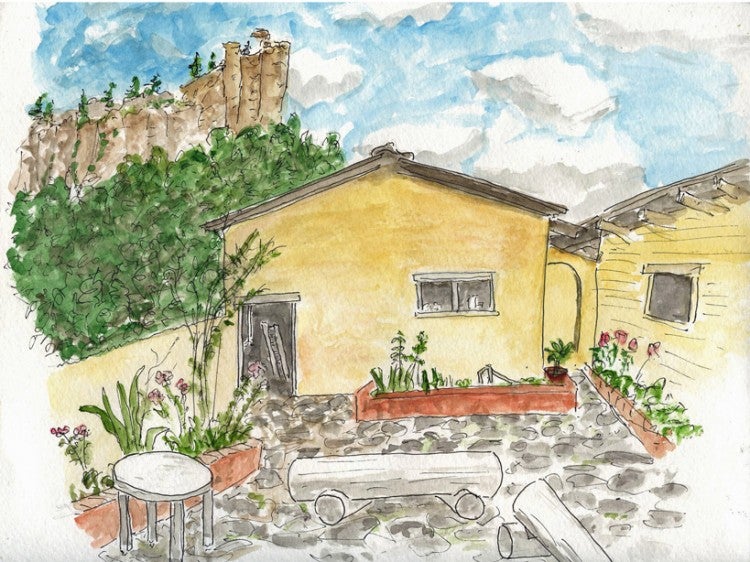
One evening on this patio, we had dinner cooked over an open fire.
|
Reluctant to face again the muddy roads after a night of heavy rain, we forayed on the grounds of the Paraiso del Oso Lodge.

|
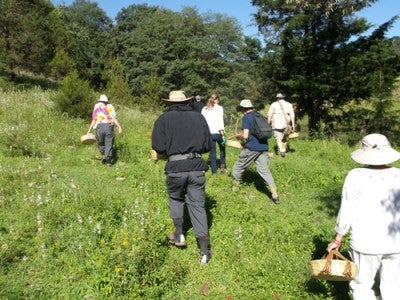
Note the wildflowers(1)
|
|

Pat’s treasure(1)
|
The next day, returning to the major canyon area, we rode a cable car (an hour ahead of schedule as a storm was approaching) across a huge chasm.
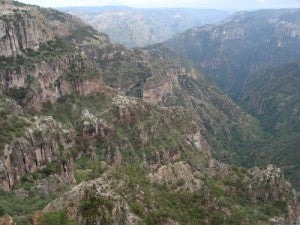
Copper Canyon view
|
|
| None of our group was interested in taking the zipline ride or using the mountain bike trail across the canyon. The scale was stunning. |
After collecting more mushrooms, we spent the next two nights in the tourist-oriented town of Creel. It had been a headquarters for the railroad construction. The train envisioned to travel from Kansas City in the U.S. to Topolobampo (on Mexico’s Pacific coast) took nearly 60 years to complete. |
|
On our penultimate day we walked the 3 k. trail to Cusarare Falls(1). |
 Then we visited a natural lake where we had a picnic and foraged for mushrooms (gathering a record ninety different species on this day). Although it rained every day, the timing was very convenient. We never had to take serious shelter. Then we visited a natural lake where we had a picnic and foraged for mushrooms (gathering a record ninety different species on this day). Although it rained every day, the timing was very convenient. We never had to take serious shelter. |
|
| Later that afternoon, we walked through, but mostly looked up at, the towering rock formations of the Valle de Los Monjes (Monks).

|

Valley of the Monks(1)
|
|
| More relevant for our group of fungophiles (mushroom lovers) was the Valle de Los Hongos (mushrooms) where large stacked rocks resembled different species of fungi. Although we were told that the colorfully dressed Tarahumara Indians did not hunt or eat many mushrooms, they apparently know what makes a good tourist attraction. |
The green, yellow, and gray lichen provided color to the mushroom caps. There were Meadow Mushroom sculptures, Morel sculptures, and several other forms that were difficult to identify by species. At first we thought these were natural rock formations but noticed some concrete bonding the rocks together. |
|
| We didn’t mind this commercialism in the valley. All the other tourist places we had visited contained multiple stands selling identical items but not featuring mushroom figures. The Tarahumara needed the income and selling souvenirs was to us preferable to begging (a common practice among children, even those as young as three or four).

Our entire group
|
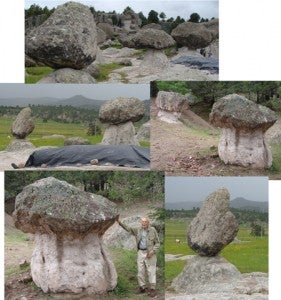
|
|
| Local people sold trinkets and souvenirs. As it had been raining, the displays were covered when we arrived, but soon the tarps were removed. Our grupo bought some of the wooden mushroom figures on display. They were obviously made in a single location as all the stands sold identical items.
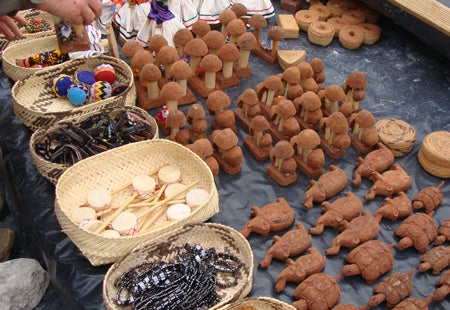
|
On the return to Chihuahua, we stopped at another cowboy-themed restaurant named Buffalo in Cuauhtemoc (a major apple-growing region) for chicken fajitas. We hardly needed our farewell banquet that evening.
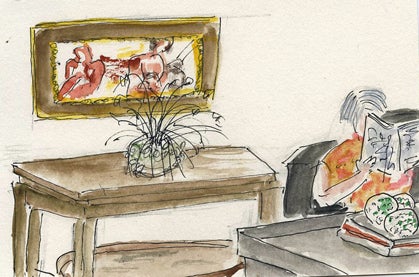
Quality Inn, Chihuahua
|
|
| Our plane departed on time but we had a 5-hour layover in Houston. We thank the Pappadeaux Seafood Kitchen for making this a pleasant stopover. We arrived home on the next-to-last bus from the airport.
(1)Photos by Erik Purre
View Bob’s Fungi paintings from Chihuahua
|
|

































